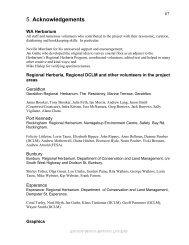Nuytsia 8: 3 (1998) - FloraBase
Nuytsia 8: 3 (1998) - FloraBase
Nuytsia 8: 3 (1998) - FloraBase
Create successful ePaper yourself
Turn your PDF publications into a flip-book with our unique Google optimized e-Paper software.
Paul G. Wilson, Helipterum: Part 1<br />
Erect herb to 25 cm high, branching at base. Principal axes slender, to 20 cm high, simple or<br />
sparsely branched, glandular puberulous, pilose beneath capitulum. Leaves linear, 8-15 mm long,<br />
c. 0.7 mm wide, glandular puberulous, margins slightly recurved. Involucre hemispherical, c. 10 mm<br />
high and wide. Outer bracts broad-elliptic, hyaline, ciliate; stereome narrow-triangular, brown,<br />
glandular puberulous. Innermost bracts: claw narrow-elliptic, c. 9 mm long, hyaline, ciliate, stereome<br />
very narrow-oblong, glabrous except for the glandular puberulous apex; limb narrow-obovate, obtuse,<br />
9-15 mm long, yellow. Corolla c. 5 mm long; tube narrow, glandular hirtellous with multicelled hairs;<br />
limb narrow-turbinate, glabrous, shortly 5-lobed, papillose within below junction of lobes. Achene<br />
compressed narrow-ellipsoid, c. 2.5 mm long, barbellate with 2-celled papillae; beak slender, smooth,<br />
to 3 mm long. Pappus more or less equal to corolla, persistent, bristles united towards base to form<br />
a tube c. 2 mm long.<br />
Additional specimen examined. WESTERN AUSTRALIA: Hamelin Pool, 16 Sept. 1984, J. Colwill s.n.<br />
(PERTH).<br />
Habitat. Found on red sand over limestone (fide H. Demarz in sched.).<br />
Distribution. Only known from near Hamelin Pool, c. 170 km south of Carnarvon, Western Australia.<br />
Notes. Haptotrichion colwillii is very similar to H. conicum which is known from an area between<br />
Carnarvon and Gascoyne Junction. The latter species differs most obviously in 1) the leaves ending<br />
in a rounded 'capitate’ tip, 2) the receptacle being narrow-conical (not rounded), and 3) the pappus sheath<br />
being split along one side.<br />
Haptotrichion colwillii is named after John Colwill, a Western Australian horticulturalist who has<br />
a particular interest in the native Asteraceae and who first collected this species.<br />
The illustration is drawn from a plant raised from seed collected by Herbert Demarz and grown at Kings<br />
Park Botanic Garden, Perth. I should like to thank the staff of Kings Park for their unstinted assistance<br />
in my study of this and other annual species of the Rhodanthe complex.<br />
Haptotrichion conicum (B. Turner) Paul G. Wilson, comb. nov.<br />
Waitzia conica B. Turner, Sida 2:428(1966). Type: 11 miles west of Gascoyne Junction, 24 Aug. 1965,<br />
B.L. Turner 5405 (holo: MEL 598263; iso: MEL 598265, PERTH).<br />
[Waitzia podolepis auct. non (Gaud.) Benth.: F. Muell., Zeitschrift des allgem. österreich. Apotheker-<br />
Vereines 34 (no.36):933-936 (1896); F. Muell., Pl. Indig. Sharks Bay 16(1883).]<br />
Distribution. Between Carnarvon and Gascoyne Junction, Western Australia.<br />
A description of this species was provided by Mueller (1883) based on a collection made by<br />
J. Polak (or Pollack) in 1882 from the Gascoyne River region (MEL 1584941). Mueller assumed that<br />
the plant he was describing was Waitzia podolepis (Gaudich.) Benth.: 'this plant represents evidently<br />
the genuine species, illustrated by Gaudichaud’, even though Mueller had seen no authentic material<br />
of that species. In 1896 Mueller again included the Pollack specimen under W. podolepis but without<br />
comment. In 1905 Diels and Pritzel stated that the Pollack collection was not W. podolepis, however,<br />
they did not give it a name.<br />
425




